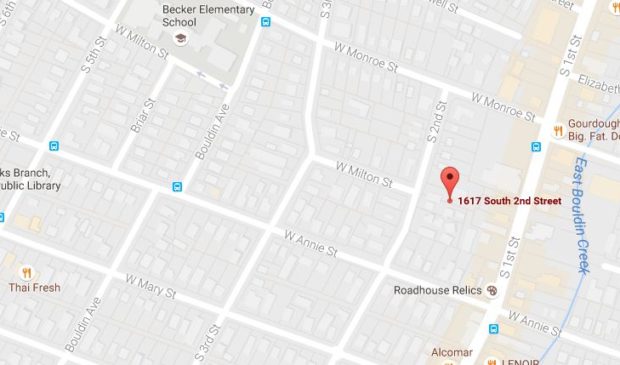‘Spot Zoning’ case moved to subcommittee
Thursday, October 27, 2016 by
Joseph Caterine A strange example of patchy zoning came before the Planning Commission at its Tuesday meeting. Chair Stephen Oliver and Commissioner Michael Wilson co-sponsored an item that proposed initiating a code amendment to create an overlay district for two lots on Second Street so that a developer, represented by Land Use Solutions, could proceed in constructing its eight-dwelling project.
Wilson said at the meeting that he had been contacted the previous week by Land Use Solutions and had been informed that the developer had miscalculated the land area related to the yield permitted by existing restrictions for 1615 and 1617 South Second St. An immediate solution to this oversight was appropriate, according to Wilson, since the developer had already spent a year reaching an agreement with the Bouldin Creek Neighborhood Association as well as accepting a private restrictive covenant and a conditional overlay.
Victoria Haase, representing Land Use Solutions, said that without the code amendment, only seven dwelling units would be permitted on the property and the entire project would have to be redesigned. “It would be like starting over from scratch,” she said.
Ex officio Member William Burkhardt commented that if there were seven units instead of eight, the units would be bigger and therefore less affordable.
“The best way to increase affordability is smaller units,” Oliver responded. “But we have portions of our code that fight against us.”
Traditionally, code amendments are not used to give entitlements to individual properties. The granting of entitlements or restrictions is usually handled by the Board of Adjustment, but Oliver said the board would not hear this case because it is a “want” and not a hardship. Moreover, a private interest cannot initiate a code amendment; in this case it would have to be initiated by the Planning Commission or one of its subcommittees.
Commissioner Nuria Zaragoza said that this was only the third time she had seen a code amendment being proposed at this level. “I would feel more comfortable with this case starting in the Small Area Planning subcommittee,” she said.
Other commissioners echoed Zaragoza’s skepticism. “I have a lot of concerns about amending the code for two sites,” Commissioner Trinity White said. “That’s the kind of maneuvering that’s landed us in the quilted land-use code we have.”
Commissioner Tom Nuckols pointed out that with the new draft code on its way next year, there is no guarantee that this amendment would even make it into the new code. “This is, in essence, spot zoning,” he said.
Agreeing that an overlay district seemed inappropriate, Commissioner Patricia Seeger asked if there was any alternative.
“We believe it is the best option,” Haase said.
At one point in the discussion, Zaragoza confused Haase for a city staff person, to everyone’s amusement. In fact, Haase was a senior planner for the city not long ago. The position is still listed as her current job on LinkedIn.
Eventually, Zaragoza motioned that the item of discussion be moved to the next Small Area Planning meeting to decide what tool would be best to make the development possible, but without initiating a code amendment. Oliver pushed back, citing the risk of sending the applicant “down a rabbit hole.”
Commissioner Fayez Kazi seconded the motion at first, but then withdrew after more discussion about possibly rezoning the lots to Single Family-6 revealed that it would likely be impossible due to the unit sizes of the planned project.
Instead, White seconded the motion, rationalizing that even if SF-6 is not possible, maybe a higher zoning would be. Oliver cautioned that typically the higher the zoning goes, the more unhappy the neighborhood is.
The motion passed 10-2, with Kazi and Commissioner James Schissler dissenting. Commissioner James Shieh was absent.
This story has been corrected to reflect the fact that Land Use Solutions is the agent for the developer, not the developer.
The Austin Monitor’s work is made possible by donations from the community. Though our reporting covers donors from time to time, we are careful to keep business and editorial efforts separate while maintaining transparency. A complete list of donors is available here, and our code of ethics is explained here.
You're a community leader
And we’re honored you look to us for serious, in-depth news. You know a strong community needs local and dedicated watchdog reporting. We’re here for you and that won’t change. Now will you take the powerful next step and support our nonprofit news organization?



